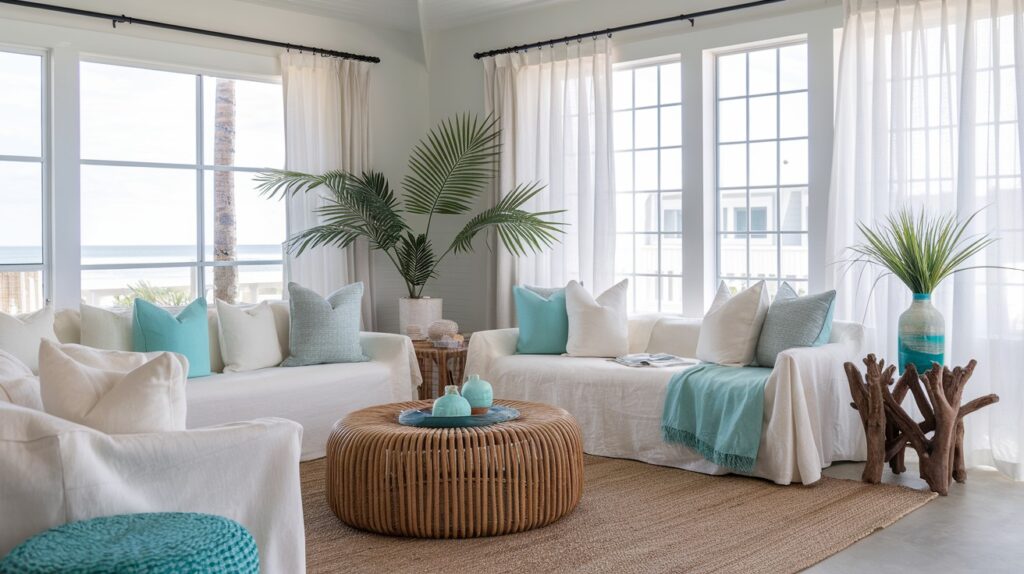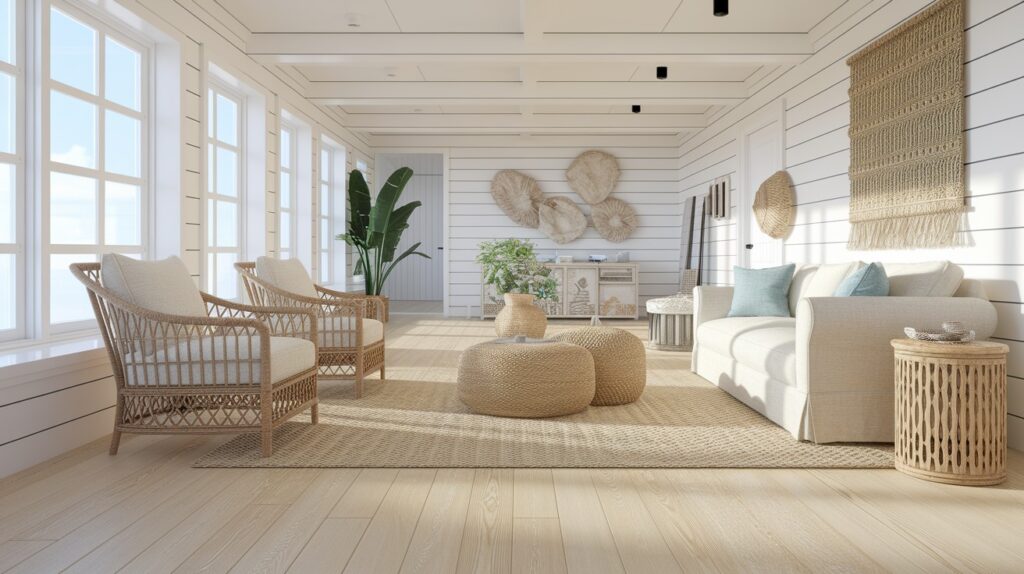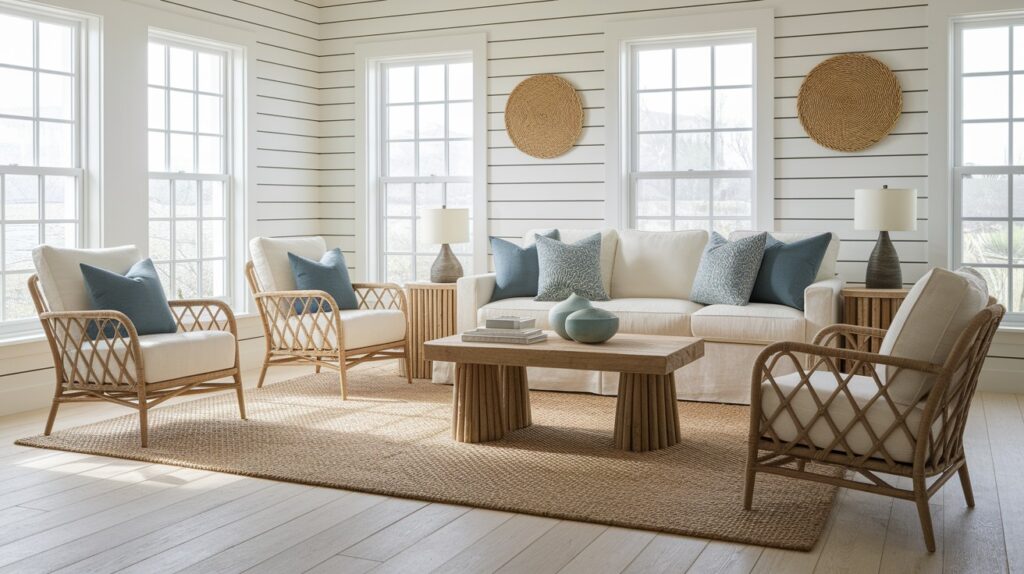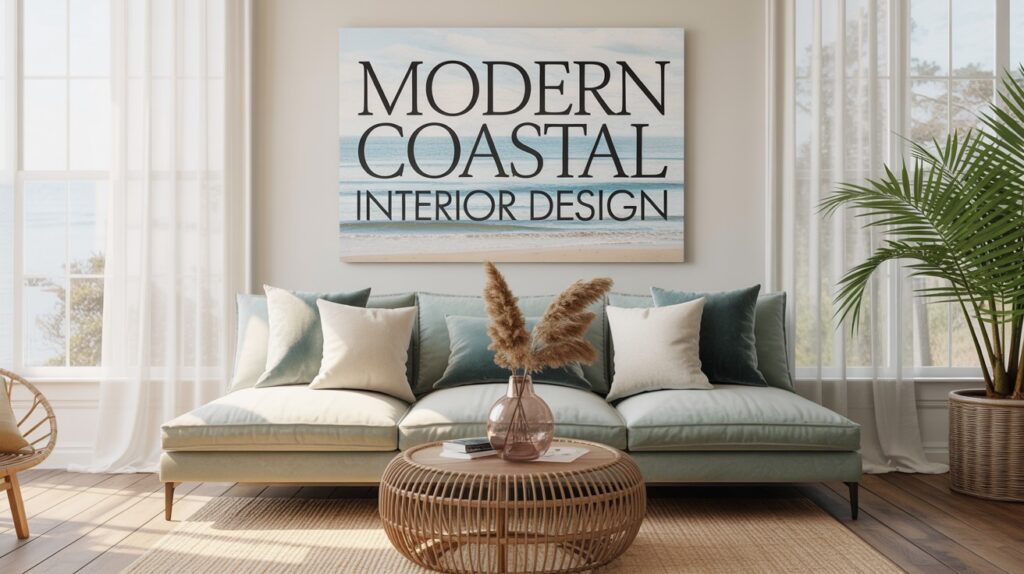I love how modern coastal design brings the ocean’s calm into our homes without the cheesy seashell overload. This style captures the peaceful feeling of seaside living through clean lines, natural materials, and soothing colors.
In 2025, more people are choosing this approach because it feels fresh and timeless. It’s not about cramming your space with anchors and sailboats. Instead, it’s about creating a serene environment that whispers “beach house” through subtle touches.
You’ll learn how to balance modern minimalism with coastal charm. I’ll show you the right colors, materials, and furniture choices. Plus, you’ll get room-by-room tips and budget-friendly ideas.
This isn’t just another design trend. It’s about creating a space where you can breathe easier and feel more connected to nature’s rhythm.
What Is Modern Coastal Interior Design?

Modern coastal design blends the relaxed vibe of beach living with contemporary style principles. Think clean lines meet ocean breeze.
The core principles focus on:
- Natural light is your best friend
- Neutral colors with ocean-inspired accents
- Textures that feel organic and lived-in
- Furniture with simple, functional shapes
Traditional coastal style often goes overboard with nautical themes. Rope everywhere. Anchors on every wall. Seashells cover every surface.
Modern coastal takes a different path.
It borrows from minimalism by keeping things simple and uncluttered. The beach inspiration comes through more subtly – in the way light moves through sheer curtains or how a piece of driftwood becomes art.
This style lets the ocean influence your space without turning it into a theme park. You feel the coastal connection through carefully chosen materials, colors that mirror the sea and sky, and an overall sense of openness that mimics the horizon.
Modern Coastal Interior Design
Create a peaceful seaside retreat with modern coastal interior design. This timeless style combines clean contemporary lines with ocean-inspired elements, making spaces that feel both sophisticated and relaxed.
Learn how to use natural materials, soothing color palettes, and thoughtful textures to bring the calming essence of coastal living into any home.
1. Essential Color Palette

Your color choices set the entire mood for modern coastal design. Start with a foundation of soft neutrals that feel like morning mist.
Soft Neutrals:
- Crisp whites that aren’t stark
- Warm creams like sea foam
- Gentle taupes that ground the space
Coastal Blues:
- Seafoam green for subtle ocean hints
- Deep navy for sophisticated contrast
- Soft aqua for playful touches
Earthy Accents:
- Sandy beige tones
- Weathered driftwood grays
- Muted sage greens
Here’s the key: use color like nature does at the beach. The sky dominates with soft blues and whites. The sand provides neutral grounding. Plants add green touches.
Pro tip: Add one bold accent color sparingly. Maybe coral throw pillows or a single piece of turquoise pottery. This modern touch prevents the space from feeling too predictable.
The 60-30-10 rule works perfectly here. 60% neutrals, 30% coastal blues, 10% accent colors.
2. Must-Have Materials & Textures

Materials make or break modern coastal design. You want things that feel like they belong near the ocean but look sophisticated enough for contemporary living.
Natural Woods:
- White oak for furniture with clean grain
- Teak for outdoor-inspired pieces
- Rattan for texture without heaviness
- Reclaimed wood for authentic weathered looks
Fabrics That Work:
- Linen for that relaxed, lived-in feeling
- Cotton for comfort and breathability
- Woven textures like hemp or jute
- Avoid anything too formal or shiny
Finish Choices: Choose matte over glossy every time. Glossy finishes feel too polished for coastal vibes. Matte finishes mimic the way salt air naturally weathers materials.
Accent Materials:
- Natural stone for countertops or accent walls
- Jute rugs for grounding larger spaces
- Sea glass collections as art pieces
- Rope details
Layer different textures together. Smooth linen against rough jute. Polished stone next to weathered wood. This creates visual interest without relying on busy patterns.
3. Furniture & Layout Ideas

Modern coastal furniture balances comfort with clean design. You want pieces that invite relaxation but don’t look sloppy.
Choose Clean Lines: Look for furniture with simple shapes. No ornate details or fussy decorations. A sofa should look like a sofa, not a boat.
Multi-Functional Pieces:
- Storage benches that double as seating
- Coffee tables with hidden compartments
- Open shelving that displays and stores
- Ottomans with removable tops
Seating Strategy: Keep seating low and approachable. High-backed formal chairs fight against the coastal flow.
Instead, choose:
- Sectionals with deep cushions
- Armchairs with relaxed proportions
- Floor cushions for casual seating
Layout Principles: Create conversation areas that feel natural. Float furniture away from walls. This mimics the open feeling of beach landscapes.
Natural light should flow freely through your space. Don’t block windows with tall furniture. Keep pathways clear and wide.
Think about how people move through beach houses – easily, casually, with room to breathe.
4. Lighting Tips

Lighting in modern coastal design should feel like natural sunlight filtering through your space all day long.
Maximize Natural Light:
- Use sheer curtains instead of heavy drapes
- Keep window treatments minimal
- Consider skylights if possible
- Place mirrors strategically to bounce light around
Choose Coastal-Style Fixtures:
- Rattan pendant lights over islands
- Woven lampshades for table lamps
- Simple pendant clusters for dining areas
- Avoid anything too ornate or metallic
Create Three Types of Lighting:
- Ambient lighting – Overall room illumination
- Task lighting – Reading lamps, under-cabinet lights
- Accent lighting – Candles, small decorative lamps
Evening Ambiance: When the sun goes down, your lighting should feel warm and inviting. Use warm LED bulbs (2700 K- 3000 K) instead of cool white. Add candles in hurricane lanterns for that perfect coastal evening glow.
Avoid harsh overhead lights. They kill the relaxed mood you’re trying to create.
5. Decor & Accessories

Accessories bring personality to modern coastal design. But restraint is key. You want thoughtful pieces, not beach gift shop overflow.
Art That Works:
- Abstract ocean paintings in soft colors
- Black and white photography of seascapes
- Simple line drawings of coastal scenes
- Avoid obvious nautical art with ships and anchors
Nautical Elements :
- Rope-wrapped mirror frames
- A single piece of coral or driftwood
- Vintage compass as an accent piece
- Quality shells in clear glass bowls
Plants add Life and Freshness:
- Fiddle leaf figs for height
- Monstera for tropical vibes
- Olive trees for a Mediterranean coastal feel
- Succulents in simple white pots
Mirrors Expand Space and Reflect Light. Choose:
- Round mirrors for softness
- Sunburst mirrors for subtle nautical nods
- Simple rectangular mirrors in natural frames
Remember: less is more. Each piece should have breathing room to shine.
Room-by-Room Coastal Vibes
Let me walk you through how modern coastal design works in each room of your home.
Living Room: Start with a neutral sofa in white or light gray linen. Add texture with a jute rug and throw pillows in soft blues. Keep coffee tables low and made from light wood. Layer lighting with table lamps and floor lamps in natural materials.
Kitchen: White cabinets create the perfect coastal foundation. Add open shelving to display dishes and glassware. Consider a subway tile backsplash in soft blue or white. Natural wood barstools bring warmth. Keep countertops light – white quartz or marble work beautifully.
Bedroom: Choose bedding in white, cream, or soft blue linen. Layer different textures with throw blankets and pillows. A natural wood headboard or rattan accent chair adds coastal charm. Keep window treatments simple to let in morning light.
Bathroom: Create a spa-like retreat with white tile and natural wood accents. Add floating shelves in reclaimed wood. Choose fixtures in brushed nickel or matte black. Include plants that thrive in humid conditions, like snake plants or pothos.
Each room should flow naturally into the next while maintaining its function.
Budget-Friendly Coastal Design Tips
- Wrap existing mirrors with rope for coastal frames
- Fill glass jars with collected shells or sea glass
- Paint furniture in coastal colors using chalk paint
- Create art from beach finds mounted in simple frames
- Shop thrift stores for wicker baskets and glass vessels
- Look for wooden furniture to paint or refinish
- Invest in key pieces like sofas, and save on accessories
- Change throw pillows and small decor seasonally
- Shop end-of-summer sales for coastal furniture
- Mix high-end pieces with budget finds
- Use plants as inexpensive natural decor
- Repurpose items you already own with coastal colors
Common Mistakes to Avoid
- Using too many shells and starfish decorations
- Adding anchor motifs to every room
- Covering everything in blue and white stripes
- Choosing sailboat artwork for multiple walls
- Sacrificing comfort for style in furniture choices
- Using too many bold blues and greens
- Forgetting to add textural variety
- Choosing the wrong-sized furniture for your space
- Changing too many items seasonally
- Making spaces feel like theme parks
- Ignoring natural light opportunities
- Overcrowding rooms with coastal accessories
Conclusion
Modern coastal design offers something special – a way to bring the ocean’s peace into your daily life without sacrificing style or sophistication.
I’ve shown you how to balance clean modern lines with coastal warmth. The key is restraint. Choose quality pieces over quantity. Let natural light and neutral colors do the heavy lifting. Add coastal touches through texture and carefully chosen accessories.
Your home should feel like a breath of fresh sea air every time you walk in. It should be a place where you can relax and recharge, surrounded by materials and colors that remind you of nature’s beauty.
Start small. Pick one room and apply these principles. See how it feels. Then expand to other areas as your confidence grows.
Ready to create your coastal retreat? Start with paint samples and fabric swatches. Build your foundation first, then add the details that make it uniquely yours.
Frequently Asked Questions
How much does it cost to create a modern coastal living room?
You can create a beautiful modern coastal living room for $2,000-$8,000, depending on your choices. A quality linen sofa runs $800-$2,500. Add a jute rug ($150-$400), coffee table ($200-$600), and lighting ($100-$300 per piece). Save money by mixing budget accessories with one or two investment pieces. DIY projects like rope mirrors or painted furniture can cut costs significantly.
What’s the difference between modern coastal and traditional beach house style?
Modern coastal focuses on clean lines and subtle ocean references, while traditional beach house style uses obvious nautical themes. Modern coastal decor avoids anchor decorations, sailboat art, and excessive blue-and-white patterns. Instead, it brings in coastal vibes through natural textures, soft color palettes, and materials like linen and weathered wood. The goal is sophistication with a seaside feel, not a themed vacation rental look.
Can I use modern coastal design in a home that’s not near the ocean?
Absolutely! Modern coastal design works anywhere because it’s about creating a calming, natural atmosphere rather than copying a beach house exactly. Focus on the core elements: natural light, neutral colors, organic textures, and clean lines. Use plants, natural materials, and soft blues to evoke that peaceful coastal feeling. Many inland homes benefit from this relaxed, airy approach to design.
What plants work best for modern coastal interiors?
Choose plants that feel tropical or Mediterranean without being too exotic. Fiddle leaf figs add height and drama. Monstera plants bring tropical vibes. Olive trees work perfectly for larger spaces. Snake plants and pothos thrive in bathrooms. Succulents in white or neutral pots add texture without overwhelming the space. Avoid anything too colorful or busy – stick to green plants in simple containers.
How do I keep modern coastal design from looking too plain or boring?
Layer different textures to create visual interest without busy patterns. Mix smooth linen with rough jute, polished stone with weathered wood. Add one accent color through pillows or artwork. Include plants for natural life and movement. Use mirrors to reflect light and create depth. Choose furniture with interesting shapes but clean lines. The key is subtle variety rather than bold contrasts.

